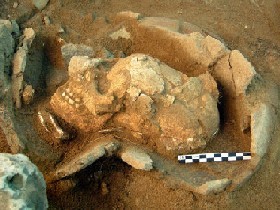A bizarre, 3,000-year-old burial site is providing rare insights into the lives of an ancient island culture.
The site in the South Pacific country of Vanuatu includes a skull in a jar and 60 headless skeletons-one of them with three skulls arrayed across its rib cage.
In 2003 construction workers at Teouma, an archaeological site on Éfaté Island, unearthed 60 skeletons. Their skulls had been taken away by mourners some time after burial.
But a new isotope analysis of teeth left behind has given researchers new clues to the lifestyle and origins of the mysterious Lapita people, ancestors of today's Polynesians and Melanesians-roughly the peoples of the central and southeastern Pacific north and east of Australia.
Isotopes are elements that have different masses, and analyzing their signatures can reveal the makeup of chemical compounds.

|
| ©Stuart Bedford, the Australian National University
|
A skull rests in an ancient pot, crushed by the weight of time and topsoil, on the South Pacific island of Éfaté, part of the country of Vanuatu.
Teeth recently taken from a mass burial site on the island have revealed clues to the lives of the Lapita people, ancestors of today's Polynesians and Melanesians.
|
"We've finally got a good sample of the population," said excavation leader Stuart Bedford of the National University of Australia at Canberra.
He said the tests proved that four individuals were not born in the immediate area. This supports evidence for a rapid Lapita expansion eastward from the island of New Guinea-which today is split into provinces of Indonesia and the independent nation of Papua New Guinea-around 3,000 years ago.
"They could have come from anywhere between [islands surrounding] New Guinea and Vanuatu," Bedford said.
"The difficulty is that we now need isotopic profiles from other regions for comparison."
The Lapita are thought to have arrived on the island of New Guinea from Southeast Asia.
They struck out across the central and southern Pacific shortly afterward, reaching the chain within 200 years.
Archaeological remains - mainly their distinctive pottery - trace the Lapita's migration and settlement as far east as Tonga and Fiji within a few generations.
Analysis of strontium and oxygen isotopes in the teeth also proved the Lapita were neither solely hunter-gatherers, as had been speculated, nor intensive farmers, Bedford said. Rather, they were a mix of the two.
"The isotope analyses are pretty much confirming a mixed diet," Bedford said. "We've got fish, pig, chicken, and cultivated plants like taro and banana."
The tests also returned evidence of a diet rich in wild-caught fish, flying foxes, and turtles.
Two contrasting theories exist about the Lapita, Bedford said.
"One is that they island-hopped, trashing local marine and indigenous fauna before moving on without too much gardening. The other (holds that) they came with a "transported landscape," complete with pigs, chickens, dogs.
"Until now, we haven't had the skeletal remains to do a decent isotopic analysis to give us that data, but the truth probably lies somewhere in the middle."
Bedford's Lapita archaeological investigation was supported in 2004 by the National Geographic Society's Committee for Research and Exploration. (National Geographic News is part of the National Geographic Society.)
Skull Secrets The team also found pottery burial jars, the oldest so far discovered in the region. The containers are similar to others found in Taiwan and in Southeast Asia. One contained a human skull.
It was common Pacific ceremonial practice to remove the skulls of the dead after decomposition and take them to a sacred place for storage.
But at Teouma, researchers found seven skulls left behind. Three were arranged on the chest of the skeleton of an elderly male, one of the four apparent visitors to the group.
"He may have been one of the senior members of the community," suggested Bedford, "or possibly one of the founding settlers of the colony."
In 2006 a similar grave was uncovered at Teouma, in which three skulls had been placed around the legs of another individual.
To Bedford's knowledge, the number three isn't specifically mystical.
Samples of the newfound ancient DNA have been sent away for analysis, but he said the overall poor state of preservation might conceal any possible familial links to the skulls found in 2006.
Professor Glenn Summerhayes, head of archaeology at Otago University in New Zealand, agreed the arrangement was a mystery.
"Mass burials are not unusual, but having heads of different people associated with the body? We haven't got a clue," Summerhayes said.
"The million-dollar question is: Who are these people? Are they the people who made the pottery? Or people they've killed, slaves they've brought in? We don't know."
Though Bedford's recent dietary analysis revealed two groups, "are we looking at two different populations, or a single population with different food taboos within it?" Summerhayes asked.
"We don't know what the answers are," he said, "but these results mean we can start asking the right questions."
Reader Comments
to our Newsletter